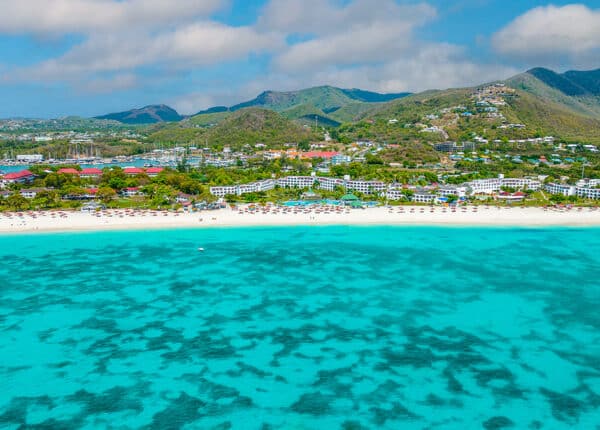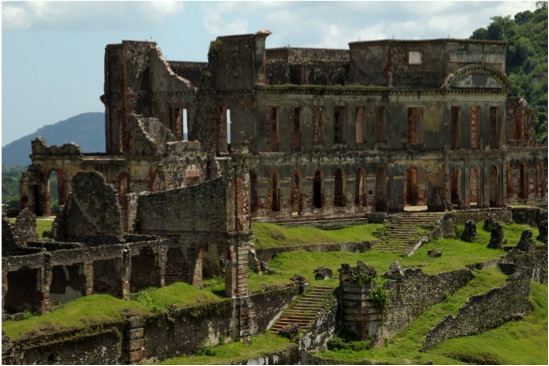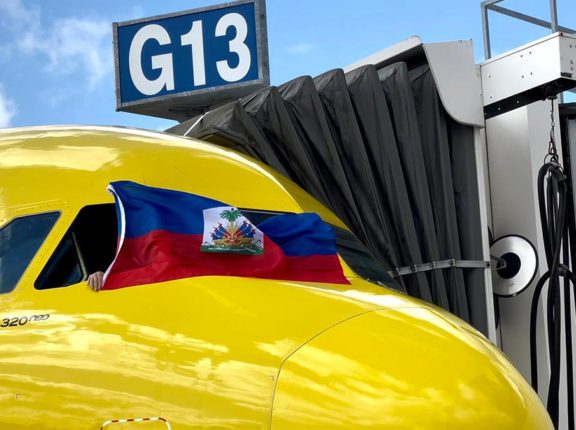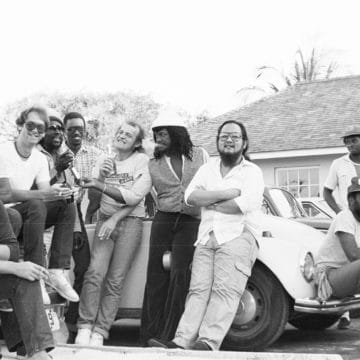Above: the Sans Souci Palace in Haiti (UN Photo/Victoria Hazou)
By Alexander Britell
Dr Ron Daniels is the President of the Institute of the Black World and the Founder of the Haiti Support Project, an organization that has been working for more than a decade to help improve engagement with Haiti and raise awareness of the situation in the country. Daniels, whose group makes an annual pilgrimage to Haiti and will be doing so again in January, recently launched a project to help revitalize the town of Milot, whose 40,000 people live at the base of the historic Sans Souci palace. Daniels talked to Caribbean Journal about the Haiti Support Project, his group’s work in Milot, and the state of reconstruction since the earthquake.
Talk about the Haiti Support Project.
Well, the Haiti Support Project was an outgrowth of a visit we made to Haiti in 1995. perspective on the part of many of us But it is really part of a longstanding perspective. Haiti was actually at the height of the sort of Black Consciousness movement in the 1960s and 1970s, but because of the Duvalier regime, was kind of off limits. And that was seen as one of the most frightening places on earth – that and the South African regime. So many of us have been familiar with some of the history of Haiti, but really had not been interacting with the people of Haiti. So we had an opportunity in 1994 to have a leader of one of the peasant movements to visit a conference we had in Baltimore, the State of the Race Conference, and he extended an invitation to us to go to Haiti in June of 1995. We did, and our goal, primarily, from the beginning, was to make sure that African Americans are engaged in the struggle for democracy and development in Haiti, given its history, and the important role Haiti has played — as an inspirational force in the era of enslavement and after that it was a beacon of hope and promise. I felt that there was not sufficient attention being paid to Haiti by African Americans, so we set about the task of doing a number of things, but primarily to do things involving humanitarian assistance, economic development and political support – but to do that within the context of African Americans becoming engaged.
What kind of impact do you think the group has made in that regard?
Well, we’ve made steady progress. We have certainly spread the word all across the country, and every year we take one or more delegations [to Haiti]. In 2004, which was quite an unfortunate year – because that was the year President Aristide was ousted, but, unfortunately for us, we were trying to organize an entire cruise ship, or half a cruise ship, to go to Haiti for the commemoration of Haiti’s bicentennial. We did manage to take 500 people, and beginning in 2006, every year we led a pilgrimage to go to the Citadel, the Sans-Souci Palace, and we’ve begun a project called the model city initiative in Milot, a small town just below the citadel, because it’s manageable. We think that working in a small town like Milot, which is right below the Citadel, can be a basis for cultural and historical tourism, so the town can benefit from that. We’ve been strategic in that regard – so if you say Ron Daniels, or the Institute for the Black World and Haiti, people know that we are the organization that, more than any other, has been constantly and relentlessly doing the work of trying to get people be interestd in Haiti and engaging people in Haiti – in a fairly effective way.
How did you choose Milot, and how has that project progressed?
When we first came to Haiti, we were doing work all over the country. We settled on the idea that it would be better to be in one place, and a place that was manageable. So Port-au-Prince, which is 4 million people, if you build schools, two or three schools, it’s not that meaningful – the benefits are not as measurable and there is not as much impact. And Milot, which has about 40,000 people, and is just south of Cap Haitien, is sitting beneath the Citadel. Part of our mission is to introduce people to the Citadel, to make sure that people make pilgrimages to the Citadel, and to get a steady flow of traffic. They have to do that by going through Milot, so we branded it the model city initiative, because we wanted to see it become a Mecca for cultural and historical tourism. What we have done in the last five years is to try to get as many kids as possible, so we provide annually, somewhere in the neighborhood of 3,000 kids with enough school supplies for a year, and we try to provide scholarships so that the fees can be paid, for about 200 to 300 schoolchildren. We’ve also established an economic development project, so people get involved not just in tourism but in related enterprises. It’s going reasonably well, and I think what we’ve done is certainly put Milot on the map. In the back of our mind is to one day have Royal Caribbean, which docks less than 30 miles away in its private destination, Labadie, to unleash some of the people by the dozens or the hundreds to get out of that little private enclave and actually come to the Citadel. And We’re working to find investors, and currently working in terms of making Milot a destination, with a small boutique hotel and a small restaurant
What else are you working on in Milot?
We’re working to find investors, and currently working in terms of making Milot a destination, with a small boutique hotel and a small restaurant. What we’re hoping to do is, which we have not yet done, to attract African Americans, in part, who will make significant investments, who will come in and invest significant dollars to remake this town completely – not to make it Disneyland, but to have it refurbished in the Haitian modality, and have it refurbished in a way that really looks back to the deal of King Henri-Christophe. It’s ambitious, but we’re making progress.
In your recent travels, what kind of progress have you seen on the ground in Haiti?
Well, it’s not been particularly spectacular, to put it mildly. And one of the problems in Haiti is you have this Catch-22. Because Haiti is such a poor country, the public sector is where people make a living, literally. But there’s been big corruption in government over the years. But because of that need in the public sector, people would provide aid to the government – so Haiti has the highest number of NGOs per capita of any country in the world. Rwanda used to have an equally high number. So the problem is that Haiti’s government has been very weak, and therefore not been able to deliver in a way that you would expect a government to deliver. There was some progress under President Preval, because he was able to establish a government that provided great transparency and access for resources. But that process was unfortunately not completed, and just as Haiti was about to achieve some takeoff, the earthquake struck. That’s the first reality – the infrastructure of the country, the ability to move around, the roads, the highways, are in less than desirable shape, to put it mildly. Having said that, far too much of the aid that came in to the private sector went to the NGOs, and the NGOs had their own particular agenda — so it’s not at all clear how much aid has actually gotten there. Some of the estimates of what was raised in the private sector amount to around $2 billion, but maybe only 50 percent of that got to Haiti, and some of that was soaked up in administration. Secondly, on the bilateral, international community side, and from aid agencies, the pace has not been as rapid as one would have wanted it to be. Of course, in the middle of that was the election, and the election slowed things down.
What else have you been seeing?
There’s also still a tremendous amount of people in tent cities. That began with about 1.5 million, and that has been reduced to about 500,000 – but it’s not progress, because these people were situated in substantial interim housing, which was the plan, but many people said look, these camps are too dangerous. The issue of abuse of women, rape, sexual assault were just very, very problematic, and so many people started to drift out of the camps, and some of them have gone back to their old neighbourhoods, and their homes, some of which are dangerous. If they had no homes, they set up a shelter, a ramshackle place in their neighbourhood. So the fact that a lot of people are no longer in the camps does not necessarily mean that there has been progress – there has been some, but I would dare say less than half a million temporary shelters have been built, and probably less than 100,000 have been built. I’ve always sort of measured the progress in that regard – how are human beings doing? Are they getting interim shelter, are they being relocated? How many permanent structures have been built? I just didn’t get a sense, based on our last visit, that that has moved anywhere nearly as well as one would have hoped.
Are there any areas in which you’ve seen progress on the economic side?
I can point to one area, this was a US corporation, Coca-Cola, partnering with peasants in Haiti, which have really made progress in mango production and marketing, both internally and externally. My wife loves mangoes, and Haitian mangoes, and I must say, when they’re in season, we can find them in our marketplace now, boldly marked “Haitian Mangoes.” There is some road construction taking place, and there are some plans for an industrial park near Cap Haitien, and on the central plateau. These will provide manufacturing jobs, but the caveat is that you’re looking at sweatshop wages — but it’s a relative situation, because people are so desperate in Haiti today that a sweatshop wage in Haiti is probably considered better than no wage. There are some efforts in Jacmel, with Wyclef Jean and a number of people, who have made it almost into an artist colony, a place that attracts the arts and performance. Jacmel is just a beautiful seaside city. And the President has said – though we have to wait and see – but some of my sources on the ground say that those in the peasant movement are confident that [Martelly] wants to focus on agriculture, and rural development, which is something people have talked about. Preval, who was an agronomist by trade, did not engage in land reforms, and the complaints were that very little resources were allocated toward trying to revitalize the agriculture sector, which is one of the areas HSP has been pushing for on the policy side. So there are some things that are moving. Frankly, things are not as bad as they were, by any stretch of the imagination, nor are they as good as they should have been or could have been.
How could reconstruction improve, in your view?
I’m in love with Haiti for lots of reasons – from a political perspective, for its historical role – but when you go to Haiti you fall in love with the people because they’re so energetic – at the ground level, the workers, the peasants, even in the Haitian diaspora, because they have projects, they want to do something, they have a lot of energy – and that energy should have been used for a mobilization of the Haitian people to take on this task. It should have been taken on as a mass effort to people to be involved on all levels. So I think engagement is a very important part of the process. There needs to be work in industry, in the agricultural sector – you need new technologies, in green enterprises, and there are people who want to get on with those kinds of things, so you don’t leave Haiti once it is “rebuilt” back to the norm – and that norm was miserable poverty. You need to beef up the government to be able to get things done, and rein in over 10,000 NGOs—who can’t all be doing their own thing. There’s got to be a way in which they’re registered and working with the government.







